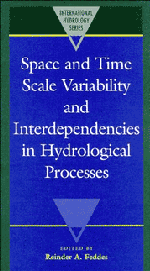Book contents
- Frontmatter
- Contents
- Acknowledgement
- OPENING ADDRESS OF THE FIRST GEORGE KOVACS COLLOQUIUM
- HETEROGENEITY AND SCALING LAND-ATMOSPHERIC WATER AND ENERGY FLUXES IN CLIMATE SYSTEMS
- SCALE PROBLEMS IN SURFACE FLUXES
- REMOTE SENSING – INVERSE MODELLING APPROACH TO DETERMINE LARGE SCALE EFFECTIVE SOIL HYDRAULIC PROPERTIES IN SOIL–VEGETATION–ATMOSPHERE SYSTEMS
- THE IMPORTANCE OF LANDSCAPE POSITION IN SCALING SVAT MODELS TO CATCHMENT SCALE HYDROECOLOGICAL PREDICTION
- THE INFLUENCE OF SUBGRID-SCALE SPATIAL VARIABILITY ON PRECIPITATION AND SOIL MOISTURE IN AN ATMOSPHERIC GCM
- MODELLING THE HYDROLOGICAL RESPONSE TO LARGE SCALE LAND USE CHANGE
- AN APPROACH TO REPRESENT MESOSCALE (SUBGRID-SCALE) FLUXES IN GCMs DEMONSTRATED WITH SIMULATIONS OF LOCAL DEFORESTATION IN AMAZONIA
- A HIERARCHICAL APPROACH TO THE CONNECTION OF GLOBAL HYDROLOGICAL AND ATMOSPHERIC MODELS
- STOCHASTIC DOWNSCALING OF GCM-OUTPUT RESULTS USING ATMOSPHERIC CIRCULATION PATTERNS
- DEPENDENCIES OF SPATIAL VARIABILITY IN FLUVIAL ECOSYSTEMS ON THE TEMPORAL HYDROLOGICAL VARIABILITY
- PROBLEMS AND PROGRESS IN MACROSCALE HYDROLOGICAL MODELLING
- PREDICTABILITY OF THE ATMOSPHERE AND CLIMATE: TOWARDS A DYNAMICAL VIEW
- FROM SCALAR CASCADES TO LIE CASCADES: JOINT MULTIFRACTAL ANALYSIS OF RAIN AND CLOUD PROCESSES
- FRACTALS ET MULTIFRACTALS APPLIQUÉS À L'ÉTUDE DE LA VARIABILITÉ TEMPORELLE DES PRÉCIPITATIONS
REMOTE SENSING – INVERSE MODELLING APPROACH TO DETERMINE LARGE SCALE EFFECTIVE SOIL HYDRAULIC PROPERTIES IN SOIL–VEGETATION–ATMOSPHERE SYSTEMS
Published online by Cambridge University Press: 05 November 2011
- Frontmatter
- Contents
- Acknowledgement
- OPENING ADDRESS OF THE FIRST GEORGE KOVACS COLLOQUIUM
- HETEROGENEITY AND SCALING LAND-ATMOSPHERIC WATER AND ENERGY FLUXES IN CLIMATE SYSTEMS
- SCALE PROBLEMS IN SURFACE FLUXES
- REMOTE SENSING – INVERSE MODELLING APPROACH TO DETERMINE LARGE SCALE EFFECTIVE SOIL HYDRAULIC PROPERTIES IN SOIL–VEGETATION–ATMOSPHERE SYSTEMS
- THE IMPORTANCE OF LANDSCAPE POSITION IN SCALING SVAT MODELS TO CATCHMENT SCALE HYDROECOLOGICAL PREDICTION
- THE INFLUENCE OF SUBGRID-SCALE SPATIAL VARIABILITY ON PRECIPITATION AND SOIL MOISTURE IN AN ATMOSPHERIC GCM
- MODELLING THE HYDROLOGICAL RESPONSE TO LARGE SCALE LAND USE CHANGE
- AN APPROACH TO REPRESENT MESOSCALE (SUBGRID-SCALE) FLUXES IN GCMs DEMONSTRATED WITH SIMULATIONS OF LOCAL DEFORESTATION IN AMAZONIA
- A HIERARCHICAL APPROACH TO THE CONNECTION OF GLOBAL HYDROLOGICAL AND ATMOSPHERIC MODELS
- STOCHASTIC DOWNSCALING OF GCM-OUTPUT RESULTS USING ATMOSPHERIC CIRCULATION PATTERNS
- DEPENDENCIES OF SPATIAL VARIABILITY IN FLUVIAL ECOSYSTEMS ON THE TEMPORAL HYDROLOGICAL VARIABILITY
- PROBLEMS AND PROGRESS IN MACROSCALE HYDROLOGICAL MODELLING
- PREDICTABILITY OF THE ATMOSPHERE AND CLIMATE: TOWARDS A DYNAMICAL VIEW
- FROM SCALAR CASCADES TO LIE CASCADES: JOINT MULTIFRACTAL ANALYSIS OF RAIN AND CLOUD PROCESSES
- FRACTALS ET MULTIFRACTALS APPLIQUÉS À L'ÉTUDE DE LA VARIABILITÉ TEMPORELLE DES PRÉCIPITATIONS
Summary
ABSTRACT This paper gives a general overview of how parameter optimization using inverse modelling can be used to infer scale-dependent effective soil hydraulic functions. In this approach, it is assumed that macroscopic flow behaviour as represented by Richards' equation is valid at all spatial scales. Thus, solution of the continuity equation with appropriate boundary conditions is independent of the size of the physical system. In this manner, for example, watershed effective soil hydraulic properties can be estimated. Since the optimization requires areal-averaged boundary conditions and measured areal-averaged flow attributes, such as water content, it is shown how remote sensing can be applied to infer these area-averaged hydrological variables.
In this way effective soil hydraulic properties are obtained from inverse modelling using the dynamical one-dimensional soil–water–vegetation model SWATRE. Areal evaporation can be obtained from reflection and thermal infrared remote sensing, while areal soil water content is estimated from microwave remote sensing techniques. The combined remote sensing and inverse modelling approach is illustrated with data taken from the HAPEXEFEDA experiment in Spain and from the catchment Hupselse Beek in the Netherlands. It is concluded that small-scale soil physics may adequately describe mesoscale behaviour.
THE PROBLEM OF SCALES
The atmospherical, hydrological and terrestrial components of the earth system operate on different time and space scales. Resolving these scaling incongruities as well as understanding and modelling the complex interaction of land surface processes at the different scales represent a major challenge for hydrologists, ecologists and meteorological scientists alike.
- Type
- Chapter
- Information
- Publisher: Cambridge University PressPrint publication year: 1995
- 3
- Cited by



